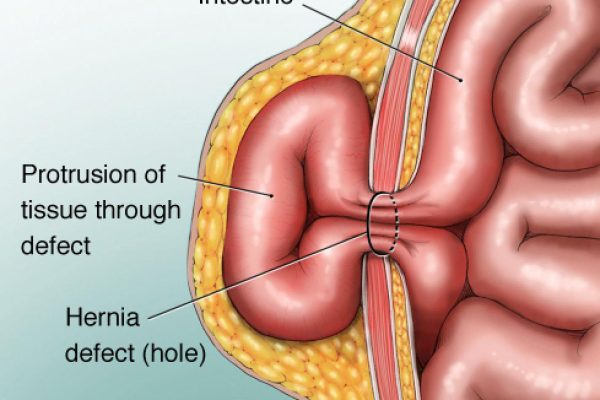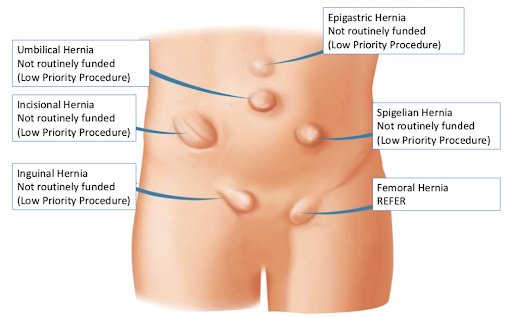Hernia Treatment in Iran

Symptoms of Inguinal Hernia
Symptoms of an inguinal hernia may include a visible bulge or swelling in the groin area, pain or discomfort when lifting heavy objects or bending over, pressure in the groin, and nausea or constipation.
Visible Bulge or Swelling: One of the most common symptoms of an inguinal hernia is a visible bulge or swelling in the groin area. This can appear more noticeable when standing up, coughing, or straining.
Pain or Discomfort: You may experience pain or discomfort that can range from a dull ache to a sharp pain, and may be more noticeable when lifting heavy objects or bending over.
Heaviness or Pressure: The feeling of heaviness or pressure in the groin area may be due to the protruding tissue putting pressure on the surrounding muscles and nerves.
Nausea and Vomiting: In some cases, an inguinal hernia can cause nausea and vomiting, particularly if the hernia becomes incarcerated (trapped).
Constipation or Difficulty Urinating: If the hernia is large enough, it may put pressure on the nearby bowel or bladder, causing constipation or difficulty urinating.
Common Causes of Inguinal Hernia
The common causes of an inguinal hernia are related to a weakness or strain on the lower abdominal wall, which can allow abdominal tissue to push through into the groin area. Some of the specific causes include:
Weakness in the Abdominal Wall: Direct inguinal hernias are related to a weak area in the inguinal canal wall that develops later in life, while indirect inguinal hernias occur due to a congenital weakness in the abdominal wall.
Increased Pressure in the Abdomen: This can occur due to straining during bowel movements or urination, heavy lifting, coughing, or sneezing.
Physical Activities: Activities that involve repetitive twisting or bending can put strain on the abdominal muscles and increase the risk of developing an inguinal hernia.
Prior Injury or Surgery: Previous abdominal surgery or injury can weaken the abdominal muscles and increase the risk of developing a hernia.
Family History: There may be a genetic predisposition to developing inguinal hernias, as they tend to run in families.
It is important to note that while these factors may increase the risk of developing an inguinal hernia, not everyone with these risk factors will develop one.
Inguinal Hernia Treatment in Iran
Inguinal Hernia Treatment in Iran depends on the severity of the condition and the symptoms experienced. Here are some common treatments for inguinal hernias:
Watchful Waiting
If the hernia is small and not causing any symptoms, the doctor may recommend simply monitoring the hernia and waiting to see if it grows or causes problems.
Lifestyle Changes
Making certain lifestyle changes can help alleviate symptoms and prevent the hernia from worsening. These may include avoiding heavy lifting or activities that cause strain on the abdomen, losing weight, and quitting smoking.
Hernia Truss
A hernia truss is a supportive undergarment that can help hold the hernia in place and alleviate symptoms. However, this is typically only recommended for people who are not good candidates for surgery.
Hernia Surgery
Surgery is often the most effective treatment for an inguinal hernia, especially if it is causing symptoms or getting larger. There are two main types of hernia surgery in Iran: open surgery and laparoscopic surgery.
Open Hernia Surgery: This type of surgery involves making a single incision in the groin area to access the hernia. The surgeon then pushes the protruding tissue back into place and repairs the weak area in the abdominal wall using sutures or a synthetic mesh.
Open surgery is performed under general anesthesia and typically requires several weeks of recovery time.
Laparoscopic Hernia Surgery: This type of surgery is less invasive than open surgery and involves making several small incisions in the abdomen. The surgeon inserts a camera and specialized instruments through these incisions to repair the hernia.
Laparoscopic hernia surgery is performed under general anesthesia and typically results in less pain and a shorter recovery time than open hernia surgery.
Both types of surgery are generally safe and effective, with a low risk of complications. However, as with any surgery, there are risks involved, including bleeding, infection, and damage to surrounding tissues.
Types of Hernia
Femoral Hernia: The femoral nerve, vein, and artery pass through the path of the femoral canal and leave the abdominal cavity to come into the thigh.
A femoral hernia causes a bulge beneath the inguinal crease around the mid-thigh area.
This condition is usually seen in women where the femoral hernias are not able to be strangulated (have their blood supply cut off) or pushed back into place (irreducible).
It is not that all the hernias are strangulated or irreducible.
All irreducible hernias need to be thoroughly examined by the doctor.
Incisional Hernia: In the case of abdominal surgery, a flaw is caused in the abdominal wall.
This procedure may lead to the development of a hernia.
This happens after 2-10% of every abdominal surgical procedure.
An incisional hernia may come back even after going through surgical repair.
Epigastric Hernia: The epigastric hernia hardly ever contains intestine and is made up of fatty tissue.
An epigastric hernia occurs between the lower part of the rib cage in the midline of the abdomen, and the navel.
This type of hernia is usually painless, and it cannot be pushed back into the abdomen.
Inguinal (Groin) Hernia: This type of hernia is mostly seen in men (25 times more often) as compared to women.
Inguinal hernia makes up around 75 percent of all abdominal-wall hernias. Direct and indirect are the two kinds of inguinal hernia.
Both indirect and direct take place in the groin area where the skin of the thigh joins the inguinal crease (the torso).
Both emerge as a bulge in the groin area.
Direct Inguinal Hernia: This hernia develops within the location of the indirect hernia, in the abdominal wall area, which is naturally thinner.
This type of hernia usually develops in elderly and middle-aged people when the abdominal wall weakens.
Indirect Inguinal Hernia: The pathway is followed by an indirect hernia that is created by the testicles at the time of fetal development, sliding from the abdomen into the scrotum.
Generally, this pathway gets closed before birth and can happen in later stages of life.
Obturator Hernia: This is a rare type of hernia that is frequently seen in women.
An obturator hernia stands out from the pelvic cavity through an opening in the obturator foramen (pelvic bone).
This type of hernia may not show any bowel obstruction, but can result in vomiting and nausea.
This is hard to diagnose as there is no bulging.
Spigelian Hernia: Spigelian hernia develops at the borderline of the rectus abdominus muscle through the Spigelian fascia.
This is also a rare type of hernia.
Umbilical Hernia: Umbilical hernia is one of the common hernias that can be noticed at the time of birth due to protrusion at the umbilicus (belly button).
This happens when the opening of the abdominal wall does not close properly.
Umbilical small hernia generally closes by the age of two.
On the other hand, large umbilical hernias need surgery at the age of 2-4 years.
This kind of hernia may also develop in later stages of life, as the spot can stay at a weaker place in the abdominal wall.
This hernia may also happen in those women who have given birth or are pregnant.

Who Should Consider Hernia Surgery?
The surgery is meant for those who have the following conditions:
-
If the hernia is growing larger.
-
If the hernia is restricting your daily activities or causing any discomfort.
-
If you are worried about the bowel getting trapped.
Hernia Repair in Iran
The surgical procedure for fixing a hernia is termed Hernia Repair or Herniorrhaphy.
There are two kinds of hernia repair, including:
-
Laparoscopic Hernia Repair: This minimally invasive procedure involves some holes in the skin.
Through these holes, long-handled surgical instruments and a laparoscope are inserted.
The entire procedure is performed under general anesthesia and involves a proper evaluation of the patient’s health that includes a physical exam and history, EKG, and lab work.
There is no feeling of pain during the surgery.
With the help of carbon dioxide gas, the abdomen is inflated, which enables the doctor to view internal structures.
To expose the weakness in the abdominal wall, the inner lining of the abdomen (peritoneum) is cut.
Also, to secure the weak area, a patch is attached below the peritoneum.
The inner lining of the abdomen is then sutured.
-
Traditional (Open) Hernia Repair: During open hernia surgery, an opening in the skin is created by cutting.
Then the hernia is fixed through this opening, which is many inches long.
Benefits of Laparoscopic Hernia Repair Surgery in Iran
-
Quick recovery time, and the patient can return to their daily activities earlier.
-
Three small incisions are made instead of 1 large incision.
-
Less postoperative pain.
-
A quick return to work.
Cost of Hernia Treatment in Iran
The cost of hernia treatment in Iran varies depending on the type of hernia and the surgical method used. Here’s a general breakdown:
-
Inguinal Hernia Surgery: Starts from around $800 and can go up to $2,500, depending on whether it is open or laparoscopic surgery
-
Umbilical Hernia Surgery: Typically begins at $650
